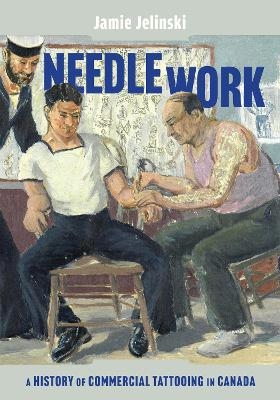
Needle Work
A History of Commercial Tattooing in Canada
Seiten
2024
McGill-Queen's University Press (Verlag)
978-0-2280-2198-8 (ISBN)
McGill-Queen's University Press (Verlag)
978-0-2280-2198-8 (ISBN)
- Titel z.Zt. nicht lieferbar
- Versandkostenfrei
- Auch auf Rechnung
- Artikel merken
Complemented by over 150 rarely seen illustrations, Needle Work moves from coast to coast and across more than one hundred years to provide a key chapter in the history of the international emergence and development of commercial tattooing.
In 1891 J. Murakami travelled from Japan, via San Francisco, to Vancouver Island and began working in and around Victoria. His occupation: creating permanent images on the skin of paying clients.
From this early example of tattooing as work, Jamie Jelinski takes us from coast to coast with detours to the United States, England, and Japan as he traces the evolution of commercial tattooing in Canada over more than one hundred years. Needle Work offers insight into how tattoo artists navigated regulation, the types of spaces they worked in, and the dynamic relationship between the images they tattooed on customers and other forms of visual culture and artistic enterprise. Merging biographical narratives with an examination of tattooing’s place within wider society, Jelinski reveals how these commercial image makers bridged conventional gaps between cultural production and practical, for-profit work, thereby establishing tattooing as a legitimate career.
Richly illustrated and drawing on archives, print media, and objects held in institutions and private collections across Canada and beyond, Needle Work provides a timely understanding of a vocation that is now familiar but whose intricate history has rarely been considered.
In 1891 J. Murakami travelled from Japan, via San Francisco, to Vancouver Island and began working in and around Victoria. His occupation: creating permanent images on the skin of paying clients.
From this early example of tattooing as work, Jamie Jelinski takes us from coast to coast with detours to the United States, England, and Japan as he traces the evolution of commercial tattooing in Canada over more than one hundred years. Needle Work offers insight into how tattoo artists navigated regulation, the types of spaces they worked in, and the dynamic relationship between the images they tattooed on customers and other forms of visual culture and artistic enterprise. Merging biographical narratives with an examination of tattooing’s place within wider society, Jelinski reveals how these commercial image makers bridged conventional gaps between cultural production and practical, for-profit work, thereby establishing tattooing as a legitimate career.
Richly illustrated and drawing on archives, print media, and objects held in institutions and private collections across Canada and beyond, Needle Work provides a timely understanding of a vocation that is now familiar but whose intricate history has rarely been considered.
Jamie Jelinski is an interdisciplinary scholar of visual culture. He lives in Montreal.
| Erscheinungsdatum | 04.09.2024 |
|---|---|
| Reihe/Serie | McGill-Queen's/Beaverbrook Canadian Foundation Studies in Art History |
| Zusatzinfo | 153 photos, colour throughout |
| Verlagsort | Montreal |
| Sprache | englisch |
| Maße | 178 x 254 mm |
| Themenwelt | Kunst / Musik / Theater ► Kunstgeschichte / Kunststile |
| Sozialwissenschaften | |
| ISBN-10 | 0-2280-2198-7 / 0228021987 |
| ISBN-13 | 978-0-2280-2198-8 / 9780228021988 |
| Zustand | Neuware |
| Informationen gemäß Produktsicherheitsverordnung (GPSR) | |
| Haben Sie eine Frage zum Produkt? |
Mehr entdecken
aus dem Bereich
aus dem Bereich


